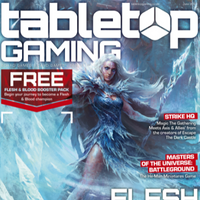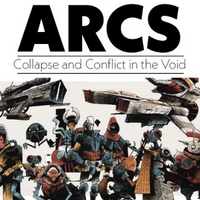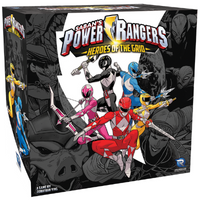02 July 2022
|
Fly, you fools.
Words by Richard Jansen-Parkes
Art from Blade Runner: The Roleplaying Game from Free League
This reminder might come in the form of an encounter with an arch-wizard that neatly dodges the party’s shenanigans by freezing time and skipping out of the dungeon with the treasure tucked beneath one arm. Or, it might be represented by a brush with an advanced alien civilization with tech that makes their space-ships look like steam trains.
Often, it’s a run into a villain that’s leagues beyond their current power level. If so, tradition usually demands that they crush the entire team in a brief combat before indulging in diabolical hubris by leaving the defeated heroes to heal up and train until they can level the field somewhat.
In any case, an encounter with a particularly powerful enemy (or even ally) usually serves a good purpose. It reminds the team that the world they’re playing in extends beyond their immediate surroundings. They aren’t the only adventurers/space ship in existence, after all.
It also lets the heroes – and the players controlling them – know there are still places for them to go. It teases the final, powerful tiers of play that they can look forward to, and gives them something to aim for.
Beating up the bad guy is sweet enough on its own. Beating up the bad guy and avenging a humiliating loss seventeen sessions earlier is even better.
However, while it can be fun to throw in a wildly mis-matched encounter into your game, it’s a tool that needs to be handled carefully.
WIPEOUT!
Perhaps the biggest risk you run when you present your first-level tomb-robbers with an ancient red dragon is accidentally killing them all and bringing the campaign to a premature end.
Usually, this happens when the heroes are too proud, stupid or convinced of their own superiority to recognise a vastly superior foe when they see one. You would be amazed how often GMs design an encounter, or even an entire campaign, around the assumption that the party won’t try to duel the monster that just levelled an entire city in front of them, only to be caught on the back foot when the fighter challenges the 100-foot monster to single combat.
If you have any intention of sticking to the rules of the game, and have already explained the consequences of the “massive damage” rules, there’s really only one way this can end.
This kind of unexpected murder is often caused by players operating under the assumption that if the GM puts a monster in front of them, they’re expected to fight it. Honestly, many of us are probably guilty of accidentally encouraging this. We neatly stick to the encounter creation rules for 99% of a campaign, and are then shocked when the players don’t seem to consider that we might include a monster that’s out of their league for that remaining 1%.
You can help to stave this off by providing subtle hints that this particular enemy is out of the ordinary, such as by having them easily destroy some monsters that the party have struggled with before. However, sometimes players can be astonishingly dense, and you need to work a little more directly.
As with many issues at the RPG table, the easiest way to combat this is with a quick out-of-game chat. You may wish to simply remind your players that the RPG world is not necessarily a balanced one, and that not every battle can be won…
AVOIDING THE RAILROAD
There is, of course, a thin line between “cannot be won” and “utterly pointless,” and it can be a hard one to walk. Stray too far towards the pointless side, and you risk putting your players on a railroad.
If you’ve not encountered this term before, a railroad is an RPG plot that cannot be deviated from. It chugs along its predetermined route, and nothing the players do can shift it from this path.
This is usually considered a bad thing to have in your game.
An encounter with a particularly powerful enemy can easily feel very railroad-ey. A large factor in this is the sheer fact that the enemy so badly outclasses the heroes. If the gulf in strength is so great that the party can’t really influence the foe’s behaviour, how can they hope to have agency on the story that surrounds that foe?
The ultimate form of this kind of railroad is the “supposed-to-lose” fight, where what should be a pivotal battle is reduced to a videogame cut-scene. Nothing the players do can possibly change the result, or stop the enemy acting out whatever evil scheme you’ve planned for them.
This can be fun for the GM, but it’s agony for the players. From personal experience, I know that sitting at the table and rolling dice that you know won’t change anything meaningful in the game is a wonderful way to lose all interest in a campaign.
One of the best ways to avoid this kind of misery is to leave the players with at least some chance of making a tangible impact. Sure, they won’t defeat the ancient dragon burning the city, but they can rescue some NPCs from a burning building. They don’t stand a chance of holding back the resurrected dark god, but if they survive three rounds of combat then the rest of the characters have time to escape.
Okay, they won’t ever defeat the all-powerful entity that you’ve got lined up for the end-of-campaign boss fight, but if they roll a critical or two they might be able to make it bleed a little. Or maybe something a little more impressive than that.
LEVELS AIN’T EVERYTHING
If there was one piece of advice I could share with every new GM out there, it would be to never make assumptions about what your party can and will do.
Necessity is the mother of all invention, and if you put your heroes in a corner you will be utterly astonished at how creative they can be. Throw your party into a battle with an impossible-to-defeat god and they’ll comb character sheets for old magic items that might be able to trap them, or slow them down. They’ll think up ways to collapse the city on them, or dig a really big pit. Players will lean fully into the spirit of Call of Cthulhu and ram your eldritch abomination with the spar of a sailing ship.
Simply having the bigger numbers doesn’t always mean that your unbeatable bad guys will be able to win, and if the plan is clever enough – and the dice lucky enough – don’t be afraid to give your players a taste of victory.
If nothing else, it only makes the story hit a little harder when you kick their arse across the dimensions two rounds later.
Looking for more?

This review came from Tabletop Gaming Magazine, which is home to all of the latest and greatest tabletop goodness. Whether you're a board gamer, card gamer, wargamer, RPG player or all of the above, find your copy here.
Get your magazine hereRead More...

If you want to read more about one of the most hotly anticipated games of the year, check out our interview with Cole Wehrle on ARCS! A new game from the designer of Root and Oath, and we've got all you need to know.
To infinity and beyond
Join us in person

We can't wait for Tabletop Gaming Live 2022! An epic weekend in Manchester full of board games, card games, roleplaying games, wargames and more, with amazing exhibitors, great games, and an opportunity to game together in person.
See you there!Treat Yourself!

Have you visited our game store? We have everything from mystery boxes, to games and accessories – including the above Power Rangers: Heroes of the Grid, with a great discount! Head over to find your new favourite game.
Visit the Game Store
Sometimes we may include links to online retailers, from which we might receive a commission if you make a purchase. Affiliate links do not influence editorial coverage and will only be used when covering relevant products








Comments
Login or register to add a comment
No comments